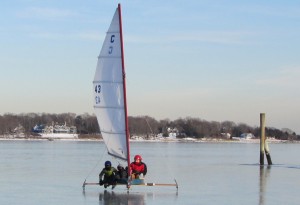Iceboating, anyone?

A rumbling growl echoed across the frozen harbor as the iceboats cruised by on Friday afternoon, the first day of iceboating on Coecles Harbor this season.
Sailors in four iceboats harnessed a steady breeze and crisscrossed the ice from morning until late in the afternoon.
“It was beautiful out there,” said John Needham, the owner of Coecles Harbor Marina and an ice boat enthusiast who has been involved in iceboating for about a decade. “Smooth — as good as it gets.”
It was the first day the ice has been thick enough for it to be safe. “There’s been ice here for two weeks, but it hasn’t been strong enough,” he said. On Friday the ice was around four to five inches thick, he said.
Needham owned two of the boats that were on the ice Friday; James Eklund and a Shelter Island bay constable, Butch Labrozzi, owned the other two. Though there were just four boats, many sailors traded spots in and out throughout the day.
The boats usually take a good shove to get going, which was happily provided by the sailors and spectators hanging out near the shore at Coecles Harbor Marina, where the boats were launched.
Crossing the ice in Needham’s classic teal gambit iceboat harkens back to an earlier time, giving the rider the sound and feel “very reminiscent of an old wooden roller coaster” as it rumbles across the frozen sheet, he said. An ice boat is sailed just like a regular sailboat, he said, except instead of steering with a rudder in the water, the iceboat sailor uses a tiller to turn one of three runners, or metal blades, that change the boat’s direction.
The runners make it possible to go much faster than a soft-water sailboat since the metal blades make much less friction than the bottom of soft-water sailboats. The iceboats can go about three times the speed of the wind.
In many ways, iceboating is more difficult than soft-water boating, Needham explained. “In a regular sailboat, there’s physical clues as to what the wind is going to do,” such as ripples in the water or the direction sailboats are facing. But when you’re ice boating, “gusts and wind shifts are complete surprises. It’s part of the thrill. You’re moving along at a nice slow speed and then all of a sudden a gust hits and you’re going 20 miles per hour.”
Though a sailor can move across the ice extremely fast, it’s not a dangerous sport with the right mind-set, Needham said. “It takes some awareness and common sense and some instruction, and some experience,” he explained. Like many ice skaters or ice fisherman, iceboat sailors carry two ice picks in a wooden case on a rope around their neck to pull themselves out in case they somehow fall off the boat and land in the water.
The sailors typically have a very short season, he explained, just two weeks or so in the first half of February, though an especially cold winter can extend the season until the end of February. Even in those two weeks, it can be difficult to find perfect conditions. “You need some wind, but you don’t want it to be too windy, either,” he explained. On Saturday it was rainy and by Sunday the ice was too thin again to safely sail. “And if it’s zero degrees out, everybody’s miserable,” said Needham.
But Friday’s mix of just enough wind, a temperature just below freezing and thick ice made for the perfect afternoon. The sailors hope to see another few days like it before the ice melts away.



